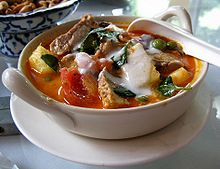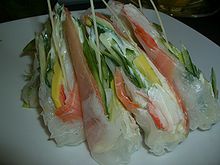- Fusion cuisine
-
This is a combination of Japanese and Vietnamese cuisine: smoked salmon wrapped in rice paper, with avocado, cucumber, and crab stick

Fusion cuisine combines elements of various culinary traditions while not being categorized per any one particular cuisine style, and can pertain to innovations in many contemporary restaurant cuisines since the 1970s.[1]
Contents
Categories and types
Fusion cuisine is general term for the combination of various forms of cookery, and the concept can take several forms. One approach is regional fusion that combines different cuisines of a region or sub-region into a single eating experience. Of this sort, Asian fusion restaurants have become popular in many parts of the United States and United Kingdom, often featuring South Asian, East Asian, and South-East Asian dishes alongside one another and offering dishes that are inspired combinations of such cuisines.
In Australia, due to the increasing influx of migrants, fusion cuisine is being reinvented and is becoming increasingly the norm at numerous cafes and restaurants; with Melbourne and Sydney now being considered as some of the best cities in the world with regard to the quality and creativity of Asian-fusion restaurants.[citation needed]
Another incarnation of fusion cuisine is a more eclectic approach, featuring original dishes using varieties of ingredients from various cuisines and regions and combining them. Such a restaurant might feature a wide variety of dishes inspired by a combination of various regional cuisines with new ideas.
A third approach uses foods with a form based on one cuisine, but prepared using ingredients and flavors inherent to another cuisine or cuisines. For instance, pizza made with cheddar and pepper jack cheese, salsa, refried beans and other common taco ingredients is often marketed as "Taco Pizza" or a similar concept[citation needed], and is a fusion of Italian (pizza) and Mexican cuisines. Another example of this are Korean tacos. Similar approaches have been used for fusion-sushi, such as rolling maki with different types of rice and ingredients, e.g. cheetos, curry and basmati rice, cheese and salsa sauce with Spanish rice, or spiced ground lamb and capers rolled with Greek-style rice and grape leaves (resembling inside-out dolmades).
Since fusion cuisine is a general term, it is legitimately applied to either sort of restaurant. While many diners feature dishes from Greek, Italian, and sometimes Asian cuisines side-by-side, these restaurants are generally not considered fusion as they fail to combine any elements of the cooking styles and also have no over-arching fusion or eclectic theme.[citation needed][2]
Background
 Kaeng phet pet yang (Thai roast duck curry) is an example of early fusion cuisine of the cosmopolitan court of the Ayutthaya Kingdom (1350 CE to 1767 CE) combining Thai red curry, Chinese roast duck and grapes originally from Persia
Kaeng phet pet yang (Thai roast duck curry) is an example of early fusion cuisine of the cosmopolitan court of the Ayutthaya Kingdom (1350 CE to 1767 CE) combining Thai red curry, Chinese roast duck and grapes originally from Persia
This type of restaurant's success depends on a number of factors. Among these are:
- Clientele's (or prospective clientele's) cultural diversity
- Clientele's travel patterns and experiences.
- Clientele's culinary sophistication and openness to new eating experiences.
Wolfgang Puck is considered as one of the pioneers of fusion cuisine[citation needed]. However, his restaurant "Chinois" was named after the term attributed to Richard Wing, who in the 1960s combined French and Chinese cooking at the former Imperial Dynasty restaurant in Hanford, California.[3]
A sampling from the menu of an American-European-Japanese restaurant in California might include the following items[citation needed]:
- Sake cocktails
- Salad with crisp nori topping, and a miso-cilantro vinaigrette dressing
- Rock shrimp dumplings
- Eel, lettuce and tomato sushi handroll
- Poached tofu
See also
References
- ^ Lindsey, Robert (1985-08-18)). "CALIFORNIA GROWS HER OWN CUISINE". New York Times. http://query.nytimes.com/gst/fullpage.html?res=9E02E0DD1F38F93BA2575BC0A963948260&sec=travel&pagewanted=print.
- ^ Maui: A Foodie’s Journey
- ^ Khokha, Sasha (2005-07-15)). "In Rural California, an Imperial Dynasty Ends". National Public Radio. http://www.npr.org/templates/story/story.php?storyId=5298206.
External links
 Media related to Fusion cuisine at Wikimedia CommonsCategories:
Media related to Fusion cuisine at Wikimedia CommonsCategories:
Wikimedia Foundation. 2010.

